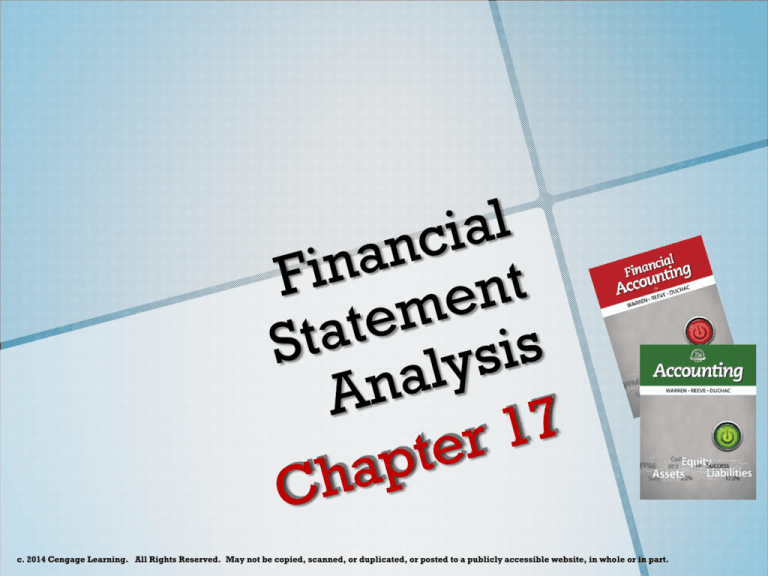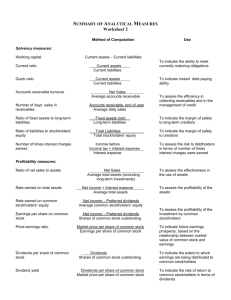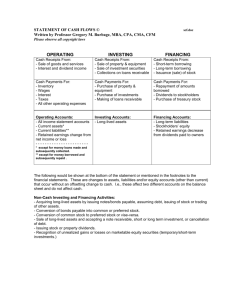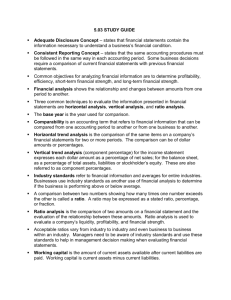
c. 2014 Cengage Learning. All Rights Reserved. May not be copied, scanned, or duplicated, or posted to a publicly accessible website, in whole or in part.
Learning Objectives
1.
Describe basic financial statement analytical
methods.
2.
Use financial statement analysis to assess the
solvency of a business.
3.
Use financial statement analysis to assess the
profitability of a business.
4.
Describe the contents of corporate annual
reports.
c. 2014 Cengage Learning. All Rights Reserved. May not be copied, scanned, or duplicated, or posted to a publicly accessible website, in whole or in part.
Basic Analytical Methods
o
Users analyze a company’s financial
statements using a variety of analytical
methods. Three such methods are as follows:
Horizontal analysis
Vertical analysis
Common-sized statements
Horizontal Analysis
o The percentage analysis of increases and
decreases in related items in comparative
financial statements is called horizontal
analysis.
HORIZONTAL
ANALYSIS
HORIZONTAL
ANALYSIS
Horizontal
Analysis:
Difference
Base year (2013)
$17,000
= 3.2%
$533,000
HORIZONTAL
ANALYSIS
HORIZONTAL
ANALYSIS
Horizontal
Analysis:
Difference
Base year (2013)
$25,800
= 39.9%
$64,700
HORIZONTAL
ANALYSIS
HORIZONTAL
ANALYSIS
Horizontal
Analysis:
Difference
$296,500
= 24.0%
Base year (2013) $1,234,000
HORIZONTAL
ANALYSIS
HORIZONTAL
ANALYSIS
Horizontal
Analysis:
Difference
Base year (2013)
$37,500
= 37.5%
$ 100,000
Vertical Analysis
o A percentage analysis used to show the
relationship of each component to the total
within a single financial statement is called
vertical analysis.
Vertical Analysis
o In a vertical analysis of the balance sheet, each
asset item is stated as a percent of the total
assets.
o Each liability and stockholders’ equity item is
stated as a percent of the total liabilities and
stockholders’ equity.
VERTICAL ANALYSIS
VERTICAL ANALYSIS
Vertical
Analysis:
Current Assets
$550,000
= 48.3%
Total Assets $ 1,139,500
Vertical Analysis
o In a vertical analysis of the income statement,
each item is stated as a percent of net sales.
VERTICAL ANALYSIS
VERTICAL ANALYSIS
Vertical Analysis:
Selling expenses $191,000
= 12.8%
Net sales
$1,498,000
Common-Sized Statements
o In a common-sized statement, all items are
expressed as percentages with no dollar
amounts shown.
o Common-sized statements are useful for
comparing the current period with prior
periods, individual businesses with one
another, or one business with industry
averages.
COMMON-SIZED
STATEMENTS
c. 2014 Cengage Learning. All Rights Reserved. May not be copied, scanned, or duplicated, or posted to a publicly accessible website, in whole or in part.
Solvency Analysis
o All users of financial statements are interested
in the ability of a company to do the following:
Meet its financial obligations (debts), called
solvency.
Earn income, called profitability.
Solvency Analysis
o Solvency analysis focuses on the ability of a
business to pay its current and noncurrent
liabilities.
o Solvency and profitability are interrelated. A
company that cannot pay its debts will have
difficulty obtaining credit, which can decrease
its profitability.
Current Position Analysis
o A company’s ability to pay its current liabilities
is called current position analysis. It is of
special interest to short-term creditors.
Working Capital
o The excess of current assets over current
liabilities is called working capital. Working
capital is often used to evaluate a company’s
ability to pay current liabilities.
o Working capital is computed as follows:
Working Capital = Current Assets – Current Liabilities
Current Ratio
o The current ratio, sometimes called the
working capital ratio, also measures a
company’s ability to pay its current liabilities.
o The current ratio is computed as follows:
Current Ratio =
Current Assets
Current Liabilities
Current Ratio
o The current ratio for Lincoln Company is
computed below.
Current assets
Current liabilities
2014
$550,000
$210,000
Current ratio
2013
$533,000
$243,000
2.6
$550,000
$210,000
2.2
$533,000
$243,000
Quick Ratio
o A ratio that measures the “instant” debt-paying
ability of a company is called the quick ratio,
or acid-test ratio. It is computed as follows:
Quick Ratio =
Quick Assets
Current Liabilities
Quick assets are cash
and other assets that
can be easily
converted to cash.
Quick Assets
o The quick ratio for Lincoln Company is
computed below.
Quick assets:
Cash
Temporary Investments
Accounts receivable (net)
Total quick assets
Current liabilities
2014
$ 90,500
75,000
115,000
$280,500
$210,000
Quick ratio
1.3
$280,500
$210,000
$244,700
$243,000
2013
$ 64,700
60,000
120,000
$244,700
$243,000
1.0
Accounts Receivable Turnover
o The relationship between sales and accounts
receivable may be stated as accounts
receivable turnover. Collecting accounts
receivable as quickly as possible improves a
company’s solvency.
o The accounts receivable turnover is computed
as follows:
Accounts Receivable Turnover =
Net Sales
Average Accounts
Receivable
Accounts Receivable Turnover
o The accounts receivable turnover for Lincoln
Company is computed below.
Net sales
Accounts receivable (net):
Beginning of year
End of year
Total
Average (Total ÷ 2)
Accounts receivable turnover
$1,498,000
$117,500
2014
$1,498,000
2013
$1,200,000
$ 120,000
115,000
$ 235,000
$ 117,500
$ 140,000
120,000
$ 260,000
$ 130,000
12.7
9.2
$1,200,000
$130,000
Number of Days’ Sales in Receivables
o The number of days’ sales in receivables is an
estimate of the length of time (in days) the
accounts receivable have been outstanding. It
is computed as follows:
Number of Days’ =
Sales in Receivables
Net Sales
365
Average Accounts
Receivable
Average Daily
Sales
Number of Days’ Sales in Receivables
o The number of
days’ sales in receivables for
Lincoln Company is computed below.
2014
Average accounts receivable
(Total accounts receivable ÷ 2)
Net sales
Average daily sales
(Net sales ÷ 365)
$ 117,500
$1,498,000
$ 130,000
$1,200,000
$
$
Number of days’ sales in receivables
$117,500
$4,104
2013
4,104
28.6
$130,000
$3,288
3,288
39.5
Inventory Turnover
o The relationship between the volume of goods
(merchandise) sold and inventory may be
stated as the inventory turnover. The purpose
of this ratio is to assess the efficiency of a firm
in managing its inventory.
o The inventory turnover is computed as follows:
Inventory Turnover =
Cost of Goods Sold
Average Inventory
Inventory Turnover
o Lincoln’s inventory balance at the beginning of
2013 is $311,000.
Cost of goods sold
Inventories:
Beginning of year
End of year
Total
Average (Total ÷ 2)
Inventory turnover
2014
2013
$1,043,000
$820,000
$ 283,000
264,000
$ 547,000
$ 273,500
$311,000
283,000
$594,000
$297,000
3.8
$1,043,000
$273,500
$820,000
$297,000
2.8
Number of Days’ Sales in Inventory
o The number of days’ sales in inventory is a
rough measure of the length of time it takes to
purchase, sell, and replace the inventory.
o The number of days’ sales in inventory is
computed as follows:
Average Inventory
Number of Days’
=
Sales in Inventory
Average Daily Cost of
Goods Sold
Cost of Goods Sold
365
Number of Days’ Sales in Inventory
o The number of
days’ sales in inventory for
Lincoln Company is computed below.
Average Inventory
2014
2013
$273,500
$297,000
$547,000 ÷ 2
$594,000 ÷ 2
(continued)
Number of Days’ Sales in Inventory
o The number of
days’ sales in inventory for
Lincoln Company is computed below.
Average Inventory
Average daily cost of goods sold
2014
2013
$273,500
$2,858
$297,000
$2,247
$1,043,000 ÷
365
Number of days’ sales in inventory
$273,500
$2,858
95.7
$297,000
$2,247
$820,000 ÷
365
132.2
Ratio of Fixed Assets to Long-Term Liabilities
o The ratio of fixed assets to long-term liabilities
is a solvency measure that indicates the
margin of safety of the note-holders or
bondholders. It also indicates the ability of the
business to borrow additional funds on a longterm basis.
o The ratio is computed as follows:
Ratio of Fixed Assets to
=
Long-Term Liabilities
Fixed Assets (net)
Long-Term
Liabilities
Ratio of Fixed Assets to Long-Term Liabilities
o To illustrate, the ratio of fixed assets to longterm liabilities for Lincoln Company is
computed below.
2014
Fixed assets (net)
Long-term liabilities
$444,500
$100,000
Ratio of fixed assets to
long-term liabilities
$444,500
$100,000
4.4
$470,000
$200,000
2013
$470,000
$200,000
2.4
Ratio of Liabilities to Stockholders’ Equity
o The relationship between the total claims of
the creditors and the owners—the ratio of
liabilities to stockholders’ equity—is a
solvency measure that indicates the margin of
safety for creditors.
o The ratio is computed as follows:
Total Liabilities
Ratio of Liabilities to
=
Stockholders’ Equity
Total Stockholders’
Equity
Ratio of Liabilities to Stockholders’ Equity
o The ratio of liabilities to stockholders’ equity
for Lincoln Company is computed below.
2014
Total liabilities
Total stockholders’ equity
Ratio of liabilities to
stockholders’ equity
$310,000
$829,500
2013
$310,000
$829,500
$443,000
$787,500
0.4
0.6
$443,000
$787,500
Number of Times Interest Charges Earned
o Corporations in some industries normally have
high ratios of debt to stockholders’ equity. For
such corporations, the relative risk of the debtholders is normally measured as the number of
times interest charges are earned (during the
year), sometimes called the fixed charge
coverage ratio.
Number of Times Interest Charges Earned
o It is computed as follows:
Number of Times Interest
=
Charges Are Earned
Income Before Income Tax
+ Interest Expense
Interest Expense
Number of Times Interest Charges Earned
o The number of times interest charges are
earned for Lincoln Company is computed
below.
Income before income tax
Add interest expense
Amount available to meet
interest charges
Number of times interest
charges earned
2014
2013
$162,500
6,000
$134,600
12,000
$168,500
$146,600
28.1
$168,500
$6,000
$146,600
$12,000
12.2
Number of Times Interest Charges Earned
o The number of times interest charges are
earned can be adapted for use with dividends
on preferred stock.
o The number of times preferred dividends are
earned is computed as follows:
Number of Times
Preferred Dividends =
Are Earned
Net Income
Preferred Dividends
c. 2014 Cengage Learning. All Rights Reserved. May not be copied, scanned, or duplicated, or posted to a publicly accessible website, in whole or in part.
Profitability Analysis
o Profitability analysis focuses primarily on the
relationship between operating results and the
resources available to a business.
Ratio of Net Sales to Assets
o The ratio of net sales to assets is a profitability
measure that shows how effectively a company
utilizes its assets.
o The ratio is computed as follows:
Ratio of Net Sales to Assets =
Net Sales
Average Total
Assets
(excluding longterm investments)
Ratio of Net Sales to Assets
o The ratio of net sales to assets for Lincoln
Company is computed below.
Net sales
Total assets:
Beginning of year
End of year
Total
Average (Total ÷ 2)
2014
$1,498,000
2013
$1,200,000
$1,053,000
1,044,500
$2,097,500
$1,048,750
$1,010,000
1,053,000
$2,063,000
$1,031,500
Excludes long-term investments
(continued)
Ratio of Net Sales to Assets
o The ratio of net sales to assets for Lincoln
Company is computed below.
Net sales
Total assets:
Beginning of year
End of year
Total
Average (Total ÷ 2)
Ratio of net sales to assets
$1,498,000
$1,048,750
2014
$1,498,000
2013
$1,200,000
$1,053,000
1,044,500
$2,097,500
$1,048,750
$1,010,000
1,053,000
$2,063,000
$1,031,500
1.4
$1,200,000
$1,031,500
1.2
Rate Earned on Total Assets
o The rate earned on total assets measures the
profitability of total assets, without considering
how the assets are financed.
o It is computed as follows:
Rate Earned on Total Assets =
Net Income +
Interest Expense
Average Total Assets
Rate Earned on Total Assets
o This ratio for Lincoln Company is computed
below. Total assets are $1,187,500 at the
beginning of 2013.
Net income
Plus interest expense
Total
Total assets:
Beginning of year
End of year
Total
Average (Total ÷ 2)
Rate earned on total assets
$97,000
$1,185,000
2014
$ 91,000
6,000
$ 97,000
2013
$ 76,500
12,000
$ 88,500
$1,230,500
1,139,500
$2,370,000
$1,185,000
$1,187,500
1,230,500
$2,418,000
$1,209,000
8.2%
$88,500
$1,209,000
7.3%
Rate Earned on Stockholders’ Equity
o The rate earned on stockholders’ equity
measures the rate of income earned on the
amount invested by the stockholders.
o It is computed as follows:
Rate Earned on
=
Stockholders’ Equity
Net Income
Average Total
Stockholders’ Equity
Rate Earned on Stockholders’ Equity
o The rate for Lincoln Company is computed
below. Total stockholders’ equity is $750,000 at
the beginning of 2013.
Net income
Stockholders’ equity:
Beginning of year
End of year
Total
Average (Total ÷ 2)
Rate earned on stockholders’
equity
$91,000
$808,500
2014
$ 91,000
2013
$ 76,500
$ 787,500
829,500
$1,617,000
$ 808,500
$ 750,000
787,500
$1,537,500
$ 768,750
11.3%
10.0%
$76,500
$768,750
Rate Earned on Stockholders’ Equity
o The difference between the rate earned on
stockholders’ equity and the rate earned on
total assets is called leverage.
Rate Earned on Stockholders’ Equity
o For Lincoln Company, the effect of leverage is
computed as follows:
Rate earned on stockholders’ equity
Less rate earned on total assets
Effect of leverage
2014
11.3%
8.2
3.1%
2013
10.0%
7.3
2.7%
RATE EARNED ON
STOCKHOLDERS’
EQUITY
Rate Earned on Common Stockholders’ Equity
o The rate earned on common stockholders’
equity measures the rate of profits earned on
the amount invested by the common
stockholders.
o It is computed as follows:
Rate Earned on Common
=
Stockholders’ Equity
Net Income –
Preferred Dividends
Average Common
Stockholders’ Equity
Rate Earned on Common Stockholders’ Equity
o Lincoln Company had $150,000 of 6%
preferred stock outstanding on December 31,
2014 and 2013. Thus, preferred dividends of
$9,000 ($150,000 x 6%) are deducted from net
income. Lincoln’s common stockholders’ equity
is determined as follows:
(continued)
Rate Earned on Common Stockholders’ Equity
2014
Net income
Less preferred dividends
Total
Common stockholders’ equity:
Beginning of year
End of year
Total
Average (Total ÷ 2)
Rate earned on common
stockholders’ equity
$
$
91,000
9,000
82,000
$ 637,500
679,500
$1,317,000
$ 658,500
12.5%
$82,000
$658,500
$67,500
$618,750
2013
$
$
76,500
9,000
67,500
$ 600,000
637,500
$1,237,500
$ 618,750
10.9%
Earnings per Share on Common Stock
o Earnings per share (EPS) on common stock
measures the share of profits that are earned
by a share of common stock. GAAP requires
the reporting of earnings per share in the
income statement.
o It is computed as follows:
Net Income –
Preferred Dividends
Earnings per Share (EPS)
=
on Common Stock
Shares of Common Stock
Outstanding
Earnings per Share on Common Stock
o EPS for Lincoln Company is computed below.
Net income
Less preferred dividends
Total
Shares of common stock
Earnings per share on common stock
$82,000
50,000
2014
$91,000
9,000
$82,000
50,000
2013
$76,500
9,000
$67,500
50,000
$1.64
$1.35
$67,500
50,000
Price-Earnings Ratio
o Another profitability measure quoted by the
financial press is the price-earnings (P/E) ratio
on common stock. The price-earnings ratio on
common stock measures a company’s future
earnings prospects.
o The price-earnings ratio is computed as
follows:
Market Price per Share of
Common Stock
Price-earnings (P/E) ratio =
Earnings per Share on
Common Stock
Price-Earnings Ratio
o The P/E ratio for Lincoln Company is
computed below.
Market price per share of
common stock
Earnings per share on common
stock
Price-earnings ratio on
common stock
2014
2013
$41.00
$27.00
÷ $1.64 ÷ $1.35
25
20
Dividends per Share
o Dividends per share can be reported with
earnings per share to indicate the relationship
between dividends and earnings.
o Comparing these two per-share amounts
measures the extent to which earnings are
being distributed to common shareholders.
The ratio for dividends per share is at the top
of the next slide.
(continued)
Dividends per Share
Dividends per Share =
Dividends
Shares of Common Stock
Outstanding
o The dividends per share for Lincoln Company
are computed below.
Dividends on common stock
Shares of common stock outstanding
2014
$40,000
÷ 50,000
2013
$30,000
÷ 50,000
Dividends per share of common stock
$0.80
$0.60
DIVIDENDS AND
EARNINGS PER
SHARE
Dividend Yield
o The dividend yield on common stock
measures the rate of return to common
stockholders from cash dividends.
o It is of special interest to investors whose
objective is to earn dividends from their
investment. It is computed as follows:
Dividends per Share of
Common Stock
Dividend Yield =
Market Price per Share of
Common Stock
Dividend Yield
o The dividend yield for Lincoln Company is
computed below.
2014
Dividends per share of
common stock
Market price per share of
common stock
Dividend yield on common stock
$0.80
$41
2013
$ 0.80
$ 0.60
$41.00
$27.00
2.0%
2.2%
$0.60
$27
SUMMARY OF
ANALYTICAL MEASURES
(continued)
SUMMARY OF
ANALYTICAL MEASURES
(concluded)
c. 2014 Cengage Learning. All Rights Reserved. May not be copied, scanned, or duplicated, or posted to a publicly accessible website, in whole or in part.
Corporate Annual Reports
o In addition to the financial statements and the
accompanying notes, corporate annual reports
usually include the following sections:
Management discussion and analysis
Report on internal control
Report on fairness of the financial statements
Management Discussion and Analysis
o Management’s Discussion and Analysis
(MD&A) is required in annual reports filed with
the SEC.
o It contains management’s analysis of current
operations and its plans for the future.
o Typical items included in the MD&A are:
Management’s analysis and explanations of any
significant changes between the current and prior
year’s financial statements.
(continued)
Management Discussion and Analysis
Important accounting principles or policies that
could affect interpretation of the financial
statements.
Management’s assessment of the company’s
liquidity and the availability of capital to the
company.
Significant risk exposures that might affect the
company.
Any “off-balance-sheet” arrangements such as
leases not included directly in the financial
statements.
Report on Internal Control
o The Sarbanes-Oxley Act of 2002 requires a
report stating management’s responsibility for
establishing and maintaining internal control.
In addition, management’s assessment of the
effectiveness of internal controls over financial
reporting is included in the report.
o It also requires a public accounting firm to
verify management’s conclusions on internal
control.
Report on Fairness of Financial Statements
o All publicly held corporations are required by
the Sarbanes-Oxley Act of 2002 to have an
independent audit (examination) of their
financial statements. The CPA firm that
conducts the audit renders an opinion on the
fairness of the statements.
c. 2014 Cengage Learning. All Rights Reserved. May not be copied, scanned, or duplicated, or posted to a publicly accessible website, in whole or in part.
Unusual Items on the Income Statement
o Unusual items affecting the current period’s
income statement include the following:
Discontinued operations
Extraordinary items
Discontinued Operations
o A company may discontinue a segment of its
operations by selling or abandoning the
segment’s operations.
o A note accompanying the income statement
should describe the operations sold, including
such details as the date operations were
discontinued, the assets sold, and the effect (if
any) on current and future operations.
Discontinued Operations
o Jones Corporation produces and sells
electrical products, hardware supplies, and
lawn equipment. Because of lack of profits,
Jones discontinues its electrical products
operation and sells the remaining inventory
and other assets at a loss of $100,000. Exhibit
11 (next slide) illustrates the reporting of the
loss on the discontinued operations.
DISCONTINUED
OPERATIONS
Extraordinary Items
o An extraordinary item is defined as an event or
transaction with both of the following
characteristics:
Unusual in nature
Infrequent in occurrence
EXTRAORDINARY
ITEMS
REPORTING
EARNINGS PER
SHARE
c. 2014 Cengage Learning. All Rights Reserved. May not be copied, scanned, or duplicated, or posted to a publicly accessible website, in whole or in part.







